Dear Colleagues
It has been another busy year and we are getting ready to greet our new incoming class of ten Neuroscience Graduate Program 1st years. Yes - ten! Our program is expanding in line with the URMC strategic plan which targets growth of neuroscience research and we are very excited to be a part of this endeavor. Please read on to learn more about our new students and feel free to introduce yourselves when you meet them in the corridors come late August. To learn more about how our program fits in with current neuroscience initiatives, you can read the perspective of Dr. John Foxe, the new chair of the department of Neuroscience, and director of the Neuroscience Institute. We have also expanded our faculty, welcoming John Foxe (Neuroscience), Jesse Schallek (Ophthalmology), Kenneth Henry (Otolaryngology), Krishnan Padmanabhan (Neuroscience), and Feng (Vankee) Lin (School of Nursing) to our program.
This year we said goodbye to Fatima Rivera-Escalera, Grayson Sipe, Christina Cloninger, Brianna Sleezer, Rebecca Lowery, Ryan Dawes, and Jennifer Stripay. We wish them well and look forward to hearing about their successes in the future. We have some updates for you from our alumni, so check out the interesting things they are doing with their neuroscience PhDs.
Our students have been active within our local community but also within the Rochester community and beyond. Our collaboration with the SFN chapter and PONS in outreach is continuing, with an expanded and improved Brain Awareness Week in local schools, events at the Rochester Science Museum and outreach to high schoolers. Our students have been winning awards for their research and other activities, they have been participating in the UR BEST program and being among the first to arrange for internships locally and nationally, and assuming leadership positions in various organizations. We are so proud of all of their achievements. Additionally, our steering, admissions and first year advisory committees worked tirelessly to ensure the program’s success and I want to thank all the faculty that contribute their time and effort to these committees, as well those who teach in our graduate courses and mentor students in any capacity.
As always, I’d love to receive feedback and suggestions for the program from faculty, students and community members at any time. Feel free to e-mail, call or come by my office. Your input is important!
Regards,
Ania Majewska
Did You Know
The Department of Neuroscience has a new Chair as of October 1, 2015. John J. Foxe, Ph.D., became a research director of the DelMonte Neuroscience Institute (DNI) and the Kilian J. and Caroline F. Schmitt Chair of the Department of Neuroscience. Dr. Foxe is responsible for bringing together the leaders of the multiple departments and centers across the University that focus on the nervous system. The University of Rochester has identified neuroscience as a first priority for its strategic plan. Over the next 5-10 years there will be a coordinated expansion of neuroscience research and education programs and acceleration of the translation of scientific discoveries into new treatments.
Student Admissions for Fall 2016
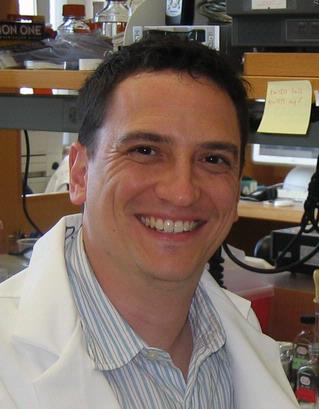
Doug Portman
Chair, NGP Admissions
Committee
Thanks to the dedicated efforts of many in our community, the Neuroscience Graduate Program had an exceptionally successful recruitment season this year. We reviewed 115 applications from around the world, and interviewed 30 candidates during two interview weekends and some additional individual visits. This year’s applicant pool was unusually strong.
As many of you know, one of our goals for this year was to increase the size of the incoming class. Thanks to commitments from DelMonte Institute Director/Neuroscience Chair John Foxe and Dean Edith Lord, we were able to make offers to 18 outstanding candidates, significantly more than in the past. Ten of these applicants accepted our offer. In addition, a transfer student, Shraddha Shah, will be joining NGP to carry out her thesis research in Dr. Liz Romanski’s lab. Together, these eleven students are a great group and we’re delighted to welcome all of them to the program.
In addition to the hard work of the admissions committee (Suzanne Haber, Ania Majewska, John Olschowka, Chris Pröschel, Liz Romanski, and Pat White), special thanks goes out to Program Coordinator Ania Dworzanski, the student members of the admissions committee (Becca Rausch, Jessie Hogestyn, Berkeley Fahrenthold, and Rianne Stowell), as well as all other current NGP students, who tirelessly escorted, entertained, and evaluated candidates. These efforts are essential in attracting the best students to our program. Thanks to everyone for making this year’s efforts a success!
 Tyler Cash-Padgett graduated from Johns Hopkins University in 2012 with a Bachelor’s degree in neuroscience and philosophy. Over the last four years he worked with Dr. Akira Sawa at the Johns Hopkins University School of Medicine on the neurobiology of schizophrenia and mood disorders. He is interested in studying how the brain processes information at the circuit level in order to perform crucial cognitive operations such as attention, working memory, and decision-making.
Tyler Cash-Padgett graduated from Johns Hopkins University in 2012 with a Bachelor’s degree in neuroscience and philosophy. Over the last four years he worked with Dr. Akira Sawa at the Johns Hopkins University School of Medicine on the neurobiology of schizophrenia and mood disorders. He is interested in studying how the brain processes information at the circuit level in order to perform crucial cognitive operations such as attention, working memory, and decision-making.
 Hyun Woong (Henry) Choi received his Bachelor of Science degree in Psychology from University of Illinois at Urbana-Champaign. At UIUC, he spent most years in the Auditory System Neuroscience lab with Dr. Daniel Llano, studying aging-related changes in mouse auditory cortex. Through work in several labs ranging from cognitive neuroscience labs to system neuroscience labs, Henry has become interested in a wide range of research areas. At URMC, he is now interested in studying reward systems and decision making in addition to neurodegenerative disease.
Hyun Woong (Henry) Choi received his Bachelor of Science degree in Psychology from University of Illinois at Urbana-Champaign. At UIUC, he spent most years in the Auditory System Neuroscience lab with Dr. Daniel Llano, studying aging-related changes in mouse auditory cortex. Through work in several labs ranging from cognitive neuroscience labs to system neuroscience labs, Henry has become interested in a wide range of research areas. At URMC, he is now interested in studying reward systems and decision making in addition to neurodegenerative disease.
 Kathleen Gates received a Bachelor’s degree in Neuroscience from St. Lawrence University located in Canton, NY. After earning her degree, she moved to Rochester to work as a Lab Technician in Dr. Sanjay Maggirwar’s lab at URMC, whose focus is secondary toxicities of chronic HIV infection. She is interested in combining her background in neuroscience and immunology to investigate viral infections of the CNS.
Kathleen Gates received a Bachelor’s degree in Neuroscience from St. Lawrence University located in Canton, NY. After earning her degree, she moved to Rochester to work as a Lab Technician in Dr. Sanjay Maggirwar’s lab at URMC, whose focus is secondary toxicities of chronic HIV infection. She is interested in combining her background in neuroscience and immunology to investigate viral infections of the CNS.
 Gavin Jenkins earned hi Bachelor’s degree in Biology from Hartwick College in Oneonta, New York. He worked closely with Dr. A.J Russo on autism biomarker research by quantifying levels of specific proteins in the blood of patients and their family members. He has recently become very interested in human induced pluripotent stem cells as a model for neurological and neurodegenerative disease. He is also interested in the relationship between glial cells, immune cells, and diseases of the nervous system. Gavin also hopes to take advantage of the URBEST program at the University of Rochester.
Gavin Jenkins earned hi Bachelor’s degree in Biology from Hartwick College in Oneonta, New York. He worked closely with Dr. A.J Russo on autism biomarker research by quantifying levels of specific proteins in the blood of patients and their family members. He has recently become very interested in human induced pluripotent stem cells as a model for neurological and neurodegenerative disease. He is also interested in the relationship between glial cells, immune cells, and diseases of the nervous system. Gavin also hopes to take advantage of the URBEST program at the University of Rochester.
 Laura Lee graduated with a Bachelor’s degree in Neuroscience from Colorado College. Most recently, she trained in the Lab of Neuropsychology at the NIH. While there, she worked closely with Dr. Richard Saunders in investigating the effects of bilateral orbitofrontal lesions on the ability to learn a recognition task, using non-human primates. At Rochester, she is interested in studying the neural circuitry of behavioral and sensory systems, particularly those associated with neurodegenerative disorders.
Laura Lee graduated with a Bachelor’s degree in Neuroscience from Colorado College. Most recently, she trained in the Lab of Neuropsychology at the NIH. While there, she worked closely with Dr. Richard Saunders in investigating the effects of bilateral orbitofrontal lesions on the ability to learn a recognition task, using non-human primates. At Rochester, she is interested in studying the neural circuitry of behavioral and sensory systems, particularly those associated with neurodegenerative disorders.
 Alexandra McHale graduated with Honors from New York University with a B.S. in Neural Science and a Minor in Psychology. She began her undergraduate research work at the Center for Neural Science studying the effects of long-term aerobic exercise in humans on behaviors associated with the prefrontal cortex, hippocampus and striatum in Dr. Wendy Suzuki’s laboratory. While working on the exercise project, Alexandra developed an interest in studying meditation. She then conducted a study examining the effect of a long-term meditation versus podcast-listening intervention in humans on tasks related to executive functioning, mood, and psychological and cortisol responses to an acute stressor. At URMC, Alexandra hopes to conduct glial cell research in order to understand their role in neurological disorders.
Alexandra McHale graduated with Honors from New York University with a B.S. in Neural Science and a Minor in Psychology. She began her undergraduate research work at the Center for Neural Science studying the effects of long-term aerobic exercise in humans on behaviors associated with the prefrontal cortex, hippocampus and striatum in Dr. Wendy Suzuki’s laboratory. While working on the exercise project, Alexandra developed an interest in studying meditation. She then conducted a study examining the effect of a long-term meditation versus podcast-listening intervention in humans on tasks related to executive functioning, mood, and psychological and cortisol responses to an acute stressor. At URMC, Alexandra hopes to conduct glial cell research in order to understand their role in neurological disorders.
 Yunpeng Pang received his Bachelor of Arts degree from Kalamazoo College in Michigan. He worked in Dr. Mark Grimes’ laboratory at University of Montana, where he studied neuroblastoma signal transduction mechanisms involving membrane trafficking of receptor tyrosine kinases and Src Family Kinase in lipid rafts. He also conducted his senior thesis project looking at membrane trafficking of amyloid precursor protein (APP) in neuroblastoma cells during apoptosis in the Grimes’ lab. He hopes to continue exploring different signal transduction mechanisms that dictate cell fate decisions for stem cells, cancer, or in neurodegenerative diseases.
Yunpeng Pang received his Bachelor of Arts degree from Kalamazoo College in Michigan. He worked in Dr. Mark Grimes’ laboratory at University of Montana, where he studied neuroblastoma signal transduction mechanisms involving membrane trafficking of receptor tyrosine kinases and Src Family Kinase in lipid rafts. He also conducted his senior thesis project looking at membrane trafficking of amyloid precursor protein (APP) in neuroblastoma cells during apoptosis in the Grimes’ lab. He hopes to continue exploring different signal transduction mechanisms that dictate cell fate decisions for stem cells, cancer, or in neurodegenerative diseases.
 Neal Shah graduated from Allegheny College in 2015 with a B.S. in Neuroscience. He was involved in a variety of labs at Allegheny, but his main project used electrophysiological techniques to determine the effects of a conotoxin on a specific N-type Calcium channel that is shown to over-activate in rats with neuropathic pain. He is currently interested in the CNS immune response and the role of neuroglia in various disorders.
Neal Shah graduated from Allegheny College in 2015 with a B.S. in Neuroscience. He was involved in a variety of labs at Allegheny, but his main project used electrophysiological techniques to determine the effects of a conotoxin on a specific N-type Calcium channel that is shown to over-activate in rats with neuropathic pain. He is currently interested in the CNS immune response and the role of neuroglia in various disorders.
 Shraddha Shah joins the NGP with a Bachelor’s degree in Electronics Engineering from University of Mumbai (India), a Master’s degree in Engineering Management from Dartmouth College and some industry experience working in the healthcare sector. While she enjoyed learning about the principles underlying the intelligent machines of today’s world, and the complex web of the healthcare system, she is truly interested in developing an understanding of information processing in the brain. Shraddha will be working with Dr. Romanski to tease apart the mechanisms by which the brain processes complex auditory and visual communication stimuli that are of social and ethological importance.
Shraddha Shah joins the NGP with a Bachelor’s degree in Electronics Engineering from University of Mumbai (India), a Master’s degree in Engineering Management from Dartmouth College and some industry experience working in the healthcare sector. While she enjoyed learning about the principles underlying the intelligent machines of today’s world, and the complex web of the healthcare system, she is truly interested in developing an understanding of information processing in the brain. Shraddha will be working with Dr. Romanski to tease apart the mechanisms by which the brain processes complex auditory and visual communication stimuli that are of social and ethological importance.
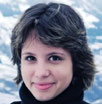 Mary-Kathryn (Kamy) Wakim graduated in 2015 with a bachelor’s degree in Cognitive Psychology from Carnegie Mellon University. She enters NGP having most recently worked as a research assistant in the lab of Dr. Jessica Cantlon, where she used neuroimaging to explore the development of mathematical concepts in young children. She is interested in using functional imaging and electrophysiology to study the effects of drug addiction on the brain.
Mary-Kathryn (Kamy) Wakim graduated in 2015 with a bachelor’s degree in Cognitive Psychology from Carnegie Mellon University. She enters NGP having most recently worked as a research assistant in the lab of Dr. Jessica Cantlon, where she used neuroimaging to explore the development of mathematical concepts in young children. She is interested in using functional imaging and electrophysiology to study the effects of drug addiction on the brain.
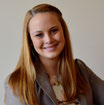 Emily Warner recently graduated with a Bachelor’s degree in neuroscience from the University of New England in Biddeford, ME. During her time at UNE, she worked with Dr. Glenn Stevenson evaluating delta/mu agonist interactions in assays of pain-depressed operant responding. During her graduate studies, Emily is interested in focusing on neurodegenerative diseases with a goal of aiding in the development of novel therapeutics. She is looking forward to moving to New York and being a part of the URMC community.
Emily Warner recently graduated with a Bachelor’s degree in neuroscience from the University of New England in Biddeford, ME. During her time at UNE, she worked with Dr. Glenn Stevenson evaluating delta/mu agonist interactions in assays of pain-depressed operant responding. During her graduate studies, Emily is interested in focusing on neurodegenerative diseases with a goal of aiding in the development of novel therapeutics. She is looking forward to moving to New York and being a part of the URMC community.
Milestones - Fall 2015 through Fall 2016
PhD Thesis Defenses
- November 2, 2015 - Fatima Rivera-Escalera (PhD), “The Contribution of CCR2+ Mononuclear Cells and Resident Microglia to Interleukin-1β Mediated Amyloid Beta Plaque Clearance”
- February 19, 2016 - Grayson Sipe(PhD), “The Role of P2Y12 in Non-Pathological Microglial Functions during Synaptic Plasticity”
- April 7, 2016 - Christina Cloninger (PhD), “Behavioral Evidence for Motion Specific Processing in the Auditory System”
- May 20, 2016 - Brianna Sleezer (PhD), “Contributions of Striatum and Orbitofrontal Cortex to Flexible Rule-Based Decision Making”
- July 7, 2016 - Rebecca Lowery (PhD), “ The Role of Microglia and Fractalkine Signaling in Experience-dependent Synaptic Plasticity”
- July 18, 2016 - Ryan Dawes (PhD), “Beta adrenergic activation constrains breast cancer progression and modulates tumor-associated exosomes”
- July 25, 2016 - Jennifer Stripay (PhD), “Targeting a network of cancer control nodes through rescue of c-Cbl: A novel therapeutic approach in GBM”
Qualifying Exams
- September 1, 2015 - Nguyen Mai (MS), “Role of lung-brain coupling in neutrophil priming and reperfusion injury following global cerebral ischemia”
- September 14, 2015 - Stephanie Syc-Mazurek (MS), “Mechanisms of Endothelin-Induced Retinal Ganglion Cell Death”
- July 14, 2016 - Rianne Stowell (MS), “Noradrenergic modulation of microglial dynamics and synaptic plasticity”
- August 2, 2016 - Colin Lockwood (MS), “Task modulation of optic flow analysis: neural and neuronal mechanisms”
Upcoming Qualifying Exams
- September 22, 2016 - Jessica Hogestyn, “Human herpesvirus 6 latency gene product alters critical oligodendrocyte precursor cell functions: Implications for demyelinating disease”
- September 29, 2016 - Patrick Miller-Rhodes, “Diametric control of microglial phenotype by Mafb and PU.1 during HIV-1 infection”
- October 2016 - Aimee Morris & Joshua Hinkle
Events - Mark Your Calendars
- Dr. Jonathan Kipnis seminar, September 11-13, 2016
- Dr. Matt Rasband seminar, September 28-30, 2016
- Dr. Linda Noble-Haeusslein seminar, October 2-4, 2016
- Undergraduate Research Day, October 21, 2016
- SFN Annual Meeting, November 12-16, 2016, San Diego
- Dr. Abbot Clark seminar, November 20-22, 2016
- NGP Holiday Party, December 2016
- Dr. Chris Koch seminar, April 26-28, 2017
- NGP Retreat, May 26, 2017; keynote speaker Dr. Eve Marder
Awards
Student Awards & Honors
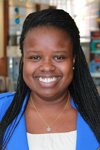 Monique Mendes was recognized at the 2014 Annual Biomedical Research Conference for Minority Students (ABRCMS) for an outstanding poster/ oral presentation and was awarded an AHA/ASA Travel Award to the 2015 Scientific Sessions in Orlando, FL.
Monique Mendes was recognized at the 2014 Annual Biomedical Research Conference for Minority Students (ABRCMS) for an outstanding poster/ oral presentation and was awarded an AHA/ASA Travel Award to the 2015 Scientific Sessions in Orlando, FL.
 Humberto Mestre was awarded by the Latin America Training Program by the Society for Neuroscience and the International Brain Research Organization a travel grant to attend the Society for Neuroscience Meeting 2015 in Chicago, and to present a poster at the International Fellows Poster Session.
Humberto Mestre was awarded by the Latin America Training Program by the Society for Neuroscience and the International Brain Research Organization a travel grant to attend the Society for Neuroscience Meeting 2015 in Chicago, and to present a poster at the International Fellows Poster Session.
 Heather Natola and Aleta Steevens received the 2016 Edward Peck Curtis Awards for Excellence in Undergraduate Teaching. Heather was nominated by the faculty in the Department of Biomedical Genetics and the Rochester Museum and Science Center. Heather is a graduate student in the Pröschel Lab, where she investigates new therapeutic approaches to spinal cord injury.
Heather Natola and Aleta Steevens received the 2016 Edward Peck Curtis Awards for Excellence in Undergraduate Teaching. Heather was nominated by the faculty in the Department of Biomedical Genetics and the Rochester Museum and Science Center. Heather is a graduate student in the Pröschel Lab, where she investigates new therapeutic approaches to spinal cord injury.
 Aleta Steevens was nominated for this award by the Neuroscience Graduate Program and her advisor, Dr. Amy Kiernan. In addition to being awarded for excellence in undergraduate teaching, Aleta was recently awarded NIH individual fellowship F31 for her work on molecular inner ear development and a travel award from Association for Research in Otolaryngology.
Aleta Steevens was nominated for this award by the Neuroscience Graduate Program and her advisor, Dr. Amy Kiernan. In addition to being awarded for excellence in undergraduate teaching, Aleta was recently awarded NIH individual fellowship F31 for her work on molecular inner ear development and a travel award from Association for Research in Otolaryngology.
 Nguyen Mai, MD/PhD student won best basic research award for her poster presented at the 11th Annual Steven Schwid Research Symposium at the URMC. She also won first place for the poster competition at the 2015 APSA/Tri-Institutional MSTP Conference at SUNY Upstate in Syracuse, NY.
Nguyen Mai, MD/PhD student won best basic research award for her poster presented at the 11th Annual Steven Schwid Research Symposium at the URMC. She also won first place for the poster competition at the 2015 APSA/Tri-Institutional MSTP Conference at SUNY Upstate in Syracuse, NY.
2015 and 2016 Convocation Awards
2015
Garrick Salois - Irving L. Spar Fellowship Award
Humberto Mestre - Merritt and Marjorie Cleveland Fellowship
Holly Beaulac - Graduate Alumni Fellowship Award
Jenn Stripay - Outstanding Student Mentor Award
2016
Alexandra McHale - Irving L. Spar Fellowship Award
Gavin Jenkins - Merritt and Marjorie Cleveland Fellowship
Neal Shah - J. Newell Stannard Graduate Student Scholarship Award
Grayson Sipe - Outstanding Student Mentor Award
Heather Natola and Humberto Mestre became official SMD Advancement Ambassador Program members. The mission of the program is to boost engagement, raise awareness and strengthen alumni relations for research, clinical, and academic programs at URMC while providing unique training to students in fundraising and donor relations.
Faculty Awards & Honors
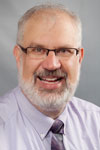 Oliver Sacks Award for Excellent in Tourette Syndrome, Tourette Association of America, 2015
Oliver Sacks Award for Excellent in Tourette Syndrome, Tourette Association of America, 2015
Jonathan Mink, Professor
Department of Neurology
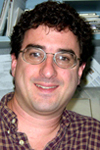 Senior Editor of the Journal of Neuroscience
Senior Editor of the Journal of Neuroscience
Greg DeAngelis, Professor
Department of Brain & Cognitive Sciences
 Beckman-Argyros Award in Vision
Beckman-Argyros Award in Vision
Sigma Xi Procter Prize
Alcon Research Institute Award
David Williams, Professor
Dean for Research in Arts, Sciences, and Engineering
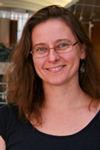 Editor of European Journal of Neuroscience(Federation on European Neuroscientists)
Editor of European Journal of Neuroscience(Federation on European Neuroscientists)
Outstanding Graduate Program Director
Ania Majewska, Associate Professor
Department of Neuroscience
 Elected to Academia Europaea
Elected to Academia Europaea
Steve Goldman, Professor
Department of Neurology
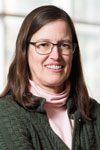 Students’ Association Government’s Professor of the Year in Engineering
Students’ Association Government’s Professor of the Year in Engineering
Laurel Carney, Professor
Department of Biomedical Engineering
Department of Neuroscience
Department of Electrical & Computer Engineering
 The 2015 1st Year Teaching Special Commendation
The 2015 1st Year Teaching Special Commendation
John Olschowka, Professor
Department of Neuroscience
 Brilliant New Investigator Award, Council for the Advancement of Nursing Science
Brilliant New Investigator Award, Council for the Advancement of Nursing Science
Feng (Vankee) Lin, Assistant Professor
Department of Nursing
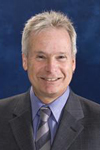 Drexel’s Hilary Koprowski Prize in Neurovirology, Drexel University College of Medicine
Drexel’s Hilary Koprowski Prize in Neurovirology, Drexel University College of Medicine
Harris Gelbard, Professor
Department of Neurology
Student Fellowships
Nguyen Mai, F30 NIH, Individual Predoctoral Fellowship, “Role of lung-brain coupling on neutrophil priming and reperfusion injury following global cerebral ischemia” (April 2015-March 2018)
Laura Yunes-Medina, F31, NIH Individual Predoctoral Fellowship to promote diversity in health-related research, “Defining CHOP-10 Dependent Adaptive ER Stress Pathways in Neurons” (August 2013-July 2017)
Aleta Steevens, F 31, NIH Individual Predoctoral Fellowship, “Elucidating the role of SOX2 in inner ear development,” (March 2016-February 2019)
CVS Training Grant, T32EY007125, current NGP appointees: Rebecca Rausch, Matthew Cavanaugh (May 2016-December 2016)
HIV Training Grant, 2T32 AI049815, current NGP appointee: Patrick Miller Rhodes (August 2016-July 2017)
Student Publications
- Wei HS, Kang H, Rasheed ID, Zhou S, Lou N, Gershteyn A, McConnell ED, Wang Y, Richardson KE, Palmer AF, Xu C, Wan J, Nedergaard M (2016 Aug 3). Erythrocytes Are Oxygen-Sensing Regulators of the Cerebral Microcirculation. Neuron.
- Lundgaard I, Lu ML, Yang E, Peng W, Mestre H, Hitomi E, Deane R, Nedergaard M (2016 Aug 1). Glymphatic clearance controls state-dependent changes in brain lactate concentration. Journal of cerebral blood flow and metabolism: official journal of the International Society of Cerebral Blood Flow and Metabolism.
- Sánchez-Hidalgo AC, Muñoz MF, Herrera AJ, Espinosa-Oliva AM, Stowell R, Ayala A, Machado A, Venero JL, de Pablos RM (2016 Jul). Chronic stress alters the expression levels of longevity-related genes in the rat hippocampus. Neurochemistry international.
- Sleezer BJ, Hayden BY (2016 Jul 15). Differential Contributions of Ventral and Dorsal Striatum to Early and Late Phases of Cognitive Set Reconfiguration. Journal of cognitive neuroscience.
- Lin CH, Chen J, Zhang Z,Johnson GV, Cooper AJ, Feola J, Bank A, Shein J, Ruotsalainen HJ, Pihlajaniemi TA, Goligorsky MS (2016 Jun). Endostatin and transglutaminase 2 are involved in fibrosis of the aging kidney. Kidney international.
- Peng W, Achariyar TM, Li B, Liao Y, Mestre H, Hitomi E, Regan S, Kasper T, Peng S, Ding F, Benveniste H, Nedergaard M, Deane R (2016 May 24). Suppression of glymphatic fluid transport in a mouse model of Alzheimer’s disease. Neurobiology of disease.
- Ding F, O’Donnell J, Xu Q, Kang N, Goldman N, Nedergaard M, (2016 Apr 29). Changes in the composition of brain interstitial ions control the sleep-wake cycle. Science (New York, N.Y.).
- Szpunar MJ, Belcher EK, Dawes RP, Madden KS, (2016 Mar). Sympathetic innervation, norepinephrine content, and norepinephrine turnover in orthotopic and spontaneous models of breast cancer. Brain, behavior, and immunity.
- Strait CE, Sleezer BJ, Blanchard TC, Azab H, Castagno MD, Hayden BY (2016 Mar 1). Neuronal selectivity for spatial positions of offers and choices in five reward regions. Journal of neurophysiology.
- Lucke-Wold BP, Logsdon AF, Manoranjan B, Turner RC, McConnell E, Vates GE, Huber JD, Rosen CL, Simard JM (2016). Aneurysmal Subarachnoid Hemorrhage and Neuroinflammation: A Comprehensive Review. International journal of molecular sciences.
- Oler JA, Tromp DP, Fox AS, Kovner R, Davidson RJ, Alexander AL, McFarlin DR, Birn RM, E Berg B, deCampo DM, Kalin NH, Fudge JL. (2016 Feb 23). Connectivity between the central nucleus of the amygdala and the bed nucleus of the striaterminalisin the non-human primate: neuronal tract tracing and developmental neuroimaging studies. Brain StructFunct.
- Sipe GO, Lowery RL, Tremblay ME, Kelly EA, Lamantia CE, Majewska AK (2016 Jan 01). Microglial P2Y12 is necessary for synaptic plasticity in mouse visual cortex. Nat Commun. 7, 10905.
- Dionisio-Santos DA (2015 Dec). The Flying Bus. The Journal of medical humanities.
- Saul ML, Helmreich DL, Rehman S, Fudge JL, (2015 Dec 17). Proliferating cells in the adolescent rat amygdala: Characterization and response to stress. Neuroscience. 311, 105-17.
- Fernandes KA, Harder JM, Williams PA, Rausch RL, Kiernan AE, Nair KS, Anderson MG, John SW, Howell GR, Libby RT, (2015 Dec). Using genetic mouse models to gain insight into glaucoma: Past results and future possibilities. Experimental eye research.
- McConnell ED, Wei HS, Reitz KM, Kang H, Takano T, Vates GE, Nedergaard M (2015 Oct 14). Cerebral microcirculatory failure after subarachnoid hemorrhage is reversed by hyaluronidase. Journal of cerebral blood flow and metabolism: official journal of the International Society of Cerebral Blood Flow and Metabolism.
- McConnell SE, O’Banion MK, Cory-Slechta DA, Olschowka JA, Opanashuk LA. (2015 Sep 01). Characterization of binge-dosed methamphetamine-induced neurotoxicity and neuroinflammation. Neurotoxicology. 50, 131-41.
- Strait CE, Sleezer BJ, Hayden BY (2015 Jun). Signatures of Value Comparison in Ventral Striatum Neurons. PLoS biology.
- Cavanaugh MR, Zhang R, Melnick MD, Das A, Roberts M, Tadin D, Carrasco M, Huxlin KR, (2015). Visual recovery in cortical blindness is limited by high internal noise. Journal of vision.
YMCA Outreach
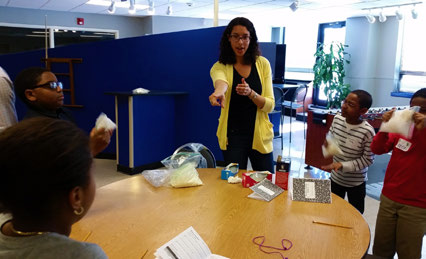
Since the beginning of this spring, Laura Yunes-Medina has been coordinating a science outreach program funded by Dr. Keith Nehrke’s NSF grant. She and a group of volunteers including undergrads, grads, lab techs, and PIs visit the Carlson MetroCenter YMCA after school program and do activities with third graders to teach them more about science. During the summer they visit the kids at the Genesee Valley Park during Summer Camp. The program not only allows the kids to learn more about science with fun activities but also to be in contact with scientists to whom they can relate. It allows us as a diverse community of scientists to become role models.
2016 Neuroscience Retreat
This year’s retreat took place on Friday, April 29, 2016 at the Memorial Art Gallery. The keynote speaker, Dr. Jeffrey Lichtman from Harvard University talked about Connectomics.
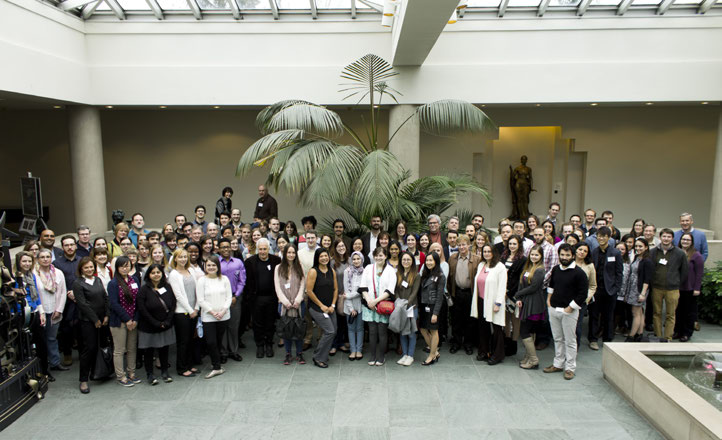
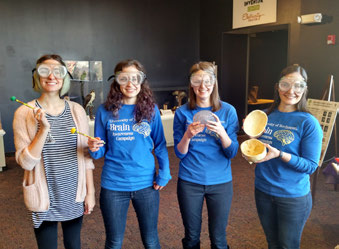 Brain Awareness Week 2016 and more...
Brain Awareness Week 2016 and more...
We had another successful year at Brain Awareness Week! This year we had 31 volunteers (not including our 9 organizers) and visited 466 students in 22 classrooms. We visited Northstar Christian Academy in Gates, School 52 in the city, Listwood Elementary in Irondequoit, and the Ginther School in Brockport, in addition to visiting the Rochester Museum and Science Center. We have heard back from the teachers and they would love us to come back! As always, our success depends on our excellent volunteers, and we appreciate those of you who dedicated your time to teach the next generation all about the brain.
Big thank you to All!
Brain Awareness Week continued after March when we collaborated with the University of Rochester Teen Health and Success Partnership. This program aims to increase the graduation rates of at risk teens in Rochester’s inner city schools by employing them at the University of Rochester and providing learning and enrichment activities to which they would not otherwise be exposed. Through this collaboration 9 high school or early college students came to the Brain Awareness Week committee to learn all about keeping their brains healthy. We taught the kids the stress pathways, as well as how drugs, nutrition and exercise affect the brain. The kids tried to walk a straight line with “drunk goggles,” made stress balls, and participated in a trivia competition to see who knew the most about healthy habits.
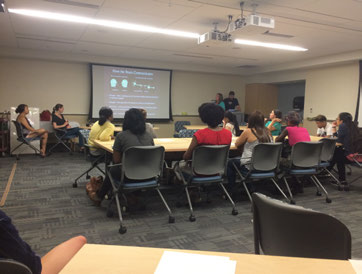
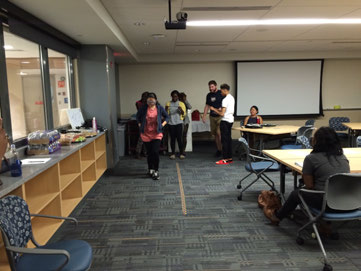
PONS
Over the past year, the Predoctoral Organization for the Neurosciences (PONS) has continued its mission to bridge the interests of the graduate and medical trainee populations at the University of Rochester Medical Center. Activities included the continuation of the PONS Luncheon Roundtable Series, this year featuring a discussion on Neurodevelopment with Julie Fudge, MD, Susan Hyman, MD, Richard Libby, PhD, and Patricia White, PhD. PONS also extended its educational and community outreach efforts thanks to the efforts of Aimee Morris. This included partaking in the TEDx Flour City Learning Laboratories, where audience members could learn about the neural control of muscle movement, as well as the role of visual processing in motor control. Aimee also coordinated the involvement of PONS in the Rochester Museum and Science Center Science of the Edge seminar series. In October 2015, fellow PONS member Molly Jaynes presented on the neuroscience of music performance with her talk “Playing an Instrument Changes Your Brain”. This was followed up in December where NGP student John O’Donnell introduced the RMSC community to the past, present, and future of connectomics with his talk “Are We Wired to Think or Just Thinking of Wires?”
As PONS enters its fourth year, the organization has reached a period of transition. Several senior members, including President Ryan Dawes, SfN Liaison and Fundraising Chair Jennifer Stripay, and Academic Activities Chair Molly Jaynes will defend their theses by the fall of 2016. As these PONS members move on, the leadership of PONS will be taken over by a team of second-year neuroscience students. All students interested in partaking in PONS leadership, or those with suggestions for new PONS activities should visit our website or contact us at urmcpons@gmail.com.
Fall 2016 course IND426: Science Communication for Diverse Audiences
Last fall, Heather Natola participated in a dry run of IND 426: Science Communication for Diverse Audiences, a student-driven and initiated course, which was also supported by faculty and staff, particularly Dina Markowitz (Environmental Sciences). This course has been approved by SMD and it is offered this fall. It provides a hands-on approach to improve science communication skills with both scientific and non-scientific audiences. The course integrates some of the newest training techniques in the field including improvisation and story telling, which serve to help scientists better connect to audiences in the moment. Student practice improvisation, elevator pitch, Three Minute Thesis, and scientific figure presentation. To register, email Laura_Shum@urmc.rochester.edu.
Out of Class Experiences
Museum of Science
- Young Audience
- Education Based
Science On Tap
- Adult Audience
- Casual Environment
Science Podcast
- Young Adult Audiences
- Work with "new media
A note from Dr. John Foxe
It has been a whirlwind year for the Department of Neuroscience, with the recruitment of three new faculty members (Krishnan Padmanabhan, Ross Maddox and Ed Lalor) and the establishment of the new Del Monte Institute for Neuroscience. The 12 months ahead promise to be just as exciting, with two new faculty recruitments well underway, major renovations of over 15,000 sq. ft. of signature neuroscience space in both the Kornberg Medical Research Building and the Rochester Institute for Brain Imaging about to begin, and a major new initiative underway in the area of Intellectual and Developmental Disabilities (IDD) research. We have also launched important new research initiatives in the areas of 1) electro-corticographic (ECoG) mapping in human patients, 2) novel neurotherapeutics, 3) sensory-motor integration in aging, 4) neurorestoration, and 5) neuropsychiatric disorders. We are delighted to welcome the incoming NGP class and look forward to their vigorous participation in our exciting new programs in the year ahead.
Rochester SfN Chapter
The Rochester Chapter of the Society for Neuroscience, now in its fourth year of activity, is continuing its efforts to promote neuroscience research, education, and outreach in the Rochester area. The Chapter’s work is supported by a chapter grant from the national Society for Neuro-science, which we were awarded again this year. The Chapter is currently led by Doug Portman (President, 2015-16), Chris Holt (Secretary/Treasurer), Krystel Huxlin (Past President), Liz Romanski and Ben Hadyen (Faculty Councillors), Sarah Heilbronner (Postdoc Councillor), and Heather Natola (Graduate Student Councillor).
One of the Chapter’s key functions is to support local collaborative efforts and events, including Brain Awareness Week and the Neuroscience Retreat. This year’s Retreat hosted our annual membership meeting, and the Chapter sponsored the retreat’s poster session by providing cash prizes for best student and postdoc posters. The Chapter also provides support to PONS, the Pre-Doctoral Organization for the Neurosciences, for its educational activities.
Our current efforts include outreach to Neuroscience-oriented Postdocs at the University. In the spring, the Chapter held a Postdoc “Open House” that was well attended by researchers from across the University. This event yielded some great new ideas for ways that the Chapter can support the Postdoc community. Our Postdoc Councillor Sarah Heilbronner is spearheading efforts to organize several new events, including a Jobs Panel coming this Fall. Contact Sarah directly for more information (sarah_heilbronner@urmc.rochester.edu), or watch your email for details.
Also on tap for this Fall is a “Post-SfN” Poster Session event, in which students and postdocs present their posters from the national SfN meeting here at home. We held this successful event for the first time last October – 20 people presented posters in the BCS space in Meliora Hall, and the event attracted roughly 50 members of the Rochester neuroscience community. We plan to do this again this fall, several weeks after November’s SfN meeting in San Diego. Keep an eye out for details.
Finally, the Chapter has hosted several “Neuroscience in Film” events over the last year. These late-afternoon gatherings feature a Neuro-science-related movie, popcorn, an introduction from a faculty member, and a post-film discussion session. Robert de Niro’s “Awakenings,” in which Robin Williams plays a character inspired by psychiatrist Oliver Sacks, was a big hit last semester; Jon Mink gave an engaging intro-
duction and lead an active discussion afterwards. The Chapter will screen “A Beautiful Mind” in September, so watch your email for details.
Visit rochestersfn.org for more information about these events and other Chapter activities. Feel free to contact any council member directly if you have feedback or would like to become involved!
Student Opportunities at UR
The Graduate Education and Postdoctoral Affairs (GEPA) office has been very actively growing academic and professional development activities at the University of Rochester School of Medicine and Dentistry. Within the last few years it created the Center for Professional Development (CPD) where students can find information on skills development in academia, career planning, writing resources, fellowship and grant resources. Every week CPD sends out Opportunities to Explore (OTE), an email newsletter for graduate students and postdocs that highlights professional and career development topics. CPD organizes seminars, presentations related to professional development including workshops like 3MT (Three Minute Thesis).
In addition to CPD, the University of Rochester Broadening Expe-riences in Scientific Training was created (URBEST). The URBEST program seeks to better prepare graduate students and postdoctoral trainees for careers outside of academia, encouraging career exploration and personal growth. It is structured to allow for a high degree of flexibility, ensuring that trainees can meet their own self-defined learning needs.
Three NGP students took advantage of internship offered by URBEST.
 Brie Sleezer worked for 3 months for the Children’s Environmental Health Network in Washington D.C., where she had a chance to work on grant writing, graphic design, website redesign, and to attend congressional briefings.
Brie Sleezer worked for 3 months for the Children’s Environmental Health Network in Washington D.C., where she had a chance to work on grant writing, graphic design, website redesign, and to attend congressional briefings.
 Rebecca Lowery spent 4 months at the White House Office for Science and Technology Policy. As an intern for the executive director of the National Science and Technology Council, she participated in the vast undertaking of coordinating science, technology, and innovation policy across the U.S. Federal Government. This experience gave Rebecca a better understanding of both how the government creates policies regulating scientific research and funding, as well as how evidence-based science is incorporated into government policies.
Rebecca Lowery spent 4 months at the White House Office for Science and Technology Policy. As an intern for the executive director of the National Science and Technology Council, she participated in the vast undertaking of coordinating science, technology, and innovation policy across the U.S. Federal Government. This experience gave Rebecca a better understanding of both how the government creates policies regulating scientific research and funding, as well as how evidence-based science is incorporated into government policies.
 Julie Feola stayed in Rochester and worked 8 hours per week over 3 months at the Center for Human Experimental Therapeutics (CHET) at the UR. She assisted with an ongoing phase III trial in a double-blind, placebo-controlled study on “Efficacy of Isradipine in Early Parkinson Disease.”
Julie Feola stayed in Rochester and worked 8 hours per week over 3 months at the Center for Human Experimental Therapeutics (CHET) at the UR. She assisted with an ongoing phase III trial in a double-blind, placebo-controlled study on “Efficacy of Isradipine in Early Parkinson Disease.”
Student Updates
- Patrick Miller-Rhodes traveled to Keystone, CO to attend “Microglia in the Brain” Keystone Symposium on June 12/16/16.
- Jonathan Andrew Syc-Mazurek was born at 5:32 am on 2/29/16. He weighed 8 pounds 1.6 oz and was 20 in long.
- Aleta Steevens and her husband Chris are expecting a baby. The puppies are excited to announce Baby Steevens coming this September!!!
- Second year NGP student, Monique Mendes, had a unique opportunity to play alongside the Rochester Philharmonic Orchestra in their Side-by-Side Reading Session – a program that pairs amateur and professional musicians in a joint rehearsal and performance at Kodak Hall on July 21st.
- MD/PhD student, Dawling Dionisio-Santos and Katherine Escalera got married on July 23, 2016.
- MD/PhD student, Nguyen Mai, was swept by the Pokemon craze. She wants to become a Pokeman Master.
- This summer Josh Hinkle, graduate student in O Labs traveled to Japan.
Alumni Updates
Jill Weimer (PhD ‘05) received her first R01 from NIH in 2014 to study intracellular trafficking in neurological disorders such as the rare pediatric Batten disease. Currently Dr. Weimer is a scientist and the director of the Children’s Health Research Center at Sanford Research in South Dakota. Most recently, she was able to develop an animal model and cell-therapy method to treat Batten disease. This research was featured in multiple media outlets, including the Chicago Tribune and Good Morning America. The first clinical trials based on her results are on the way at the Nationwide Children’s Hospital. In an interview with Chicago Tribune, Dr. Weimer explained that the basic concept of the treatment is to take a virus, strip out all non-essential elements and load it with the CLN6 gene. “The virus is still able to get into cells - in this case into neurons in the brain - but it is unable to reproduce or cause an immune response. (...) The CLN6 expressed inside of the neurons will start to make them healthier. This will strengthen the synaptic connections of the cells that were sick and maintain the health of the cells that were not sick.” In addition, Weimer said in the interview, that the glial cells surrounding and providing support to the neurons will themselves start to get healthier and will continue to work to clean up the cellular debris that is left from the cells that had died. Dr. Weimer’s research brings hope to kids with Batten disease CLN6 whose life expectancy is between 6 and 12 years.
Maria (Diehl )Faryna (PhD ‘12), husband Ethan, and recently adopted dog, Sinfo send greetings from a place called “Arból Solitario” (Lonely Tree) in the south of the island near Salinas, Puerto Rico. By the way, Sinfo is an 11 year old mixed breed. Maria continues her NRSA in Dr. Quirk’s lab and plans to visit Rochester this October for the Conte Symposium on Persistent, Maladaptive Behaviors: why we make bad choices.
Grayson Sipe, recent doctoral graduate from the Majewska lab, received the 2016 Robert Doty award for outstanding dissertation in neuroscience. Dr. Peter Shrager presented the award to Grayson at the annual neuro-science retreat on Friday, April 29, 2016. Grayson is currently a postdoctoral fellow in Dr. Mriganka Sur at MIT.
Aaron Cecala (PhD ‘09) was recently promoted to Associate Professor of Physiology at Elizabethtown College in Elizabethtown, PA. Aaron is a Director of Cognitive Science Minor and Chair of Health Professions Advisory Committee.
Zhuoxun Chen (PhD ‘12) became a dad in December 2014 and recently took his daughters on the first bullet train ride in China.
Marina (Dobreva) Stoilova (PhD ‘10) gave birth to baby boy #2. Baby Yosif was born on 7/21/16. He was 9lb 7oz and 54 inches long. A proud brother Stephen cannot wait to take Yosif home.
Qi Cui (PhD ‘09, MD ‘11) completed her residency in Ophthalmology at UCSF in 2015, and recently she finished fellowship at the at Wills Eye Institute in Philadelphia.